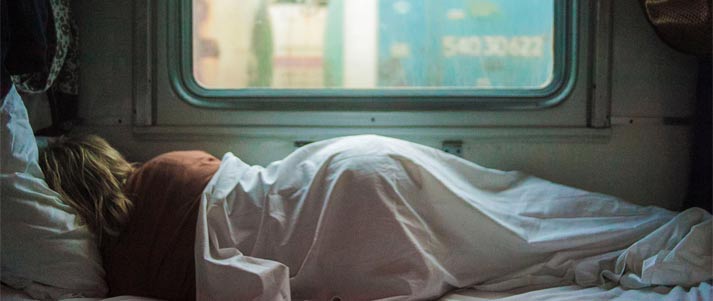Interrailing guide for beginners 2025
Fancy gallivanting around Europe by train? You need to know about interrailing – the all-you-can-ride experience that gets you (and your budget) that little bit further.

Interrailing has become a student rite of passage in recent years. If you haven't stumbled your way around Europe with a rucksack too big to carry while staying in some dodgy hostels, have you really travelled at all?
Of course, the reason interrailing around Europe is so great is because the continent is densely packed with so many diverse cultures and landscapes.
You can visit the glistening shores of Croatia, the snow-capped mountains of Austria and the tulip fields of the Netherlands without having to step foot on a pricey plane.
Plus, it makes for a cheap holiday, it's eco-friendly and gives you more flexibility than flying. This guide to interrailing for students will clue you in.
What's in this guide?
What is interrailing?

Technically, when we say interrailing, we're talking about the Interrail Pass: an all-you-can-ride ticket that lets you travel around Europe for a single, fixed price.
You're not tied down to just one city for your entire holiday. If you fancy a few days in Rome and a weekend in Istanbul, it's up for grabs.
And, unlike plane tickets, you're not stuck with iron-clad travel dates – you can change your plans and itinerary along the way.
What's the catch? Well, as you might expect from the name, it's just for train journeys. However, it is possible to use the pass on some ferries, local transport and special services (including Eurostar) as well.
If you're up for cheap travel, flexible holidays and cleaner, greener gap years, riding the rails is for you.
Where to buy interrail passes
If you're travelling from the UK, you can buy an interrail pass from My Interrail by National Rail.
Will I need a visa to travel to the EU after Brexit?
Despite the UK having left the EU, you can still travel to EU countries without having to apply for a visa. You don't need a visa if you visit as a tourist and stay for up to 90 days within a 180-day period. The same counts for Switzerland, Norway, Iceland or Liechtenstein.
This rule only applies to certain types of trips, including tourism. It's different when you visit for work or studies, but each country has different rules. For more information, you can check the gov.uk website.
Make sure that your passport is valid for at least another three months and that it's not older than 10 years. On top of that, you can use your EHIC or GHIC in EU countries. It's also important to look into getting the right travel insurance.
How much does interrailing cost?
The Interrail Pass comes in more varieties than Skittles, and while that's great for choice, it means we can't pin down just one fare.
For travellers aged 27 or under, prices range from £49 for certain One Country passes to £774 for the bumper three-month-long first-class Global Pass. You'll have to do a bit of shopping around to see which pass is right for you and what your budget can stretch to.
What you need to know is that prices vary according to:
- What type of pass you pick, and how long you want it to last
- How many days you want to travel
- Whether you travel first or second-class
- Your age – if you're under 28, you're eligible for youth fares.
How long does an Interrail Pass last for?
There is a whole range of different options here depending on how long you want to travel.
There are two main types of Interrail Pass – the Global Pass and the One Country Pass, and these dictate where you can travel. From there, you can then choose how often you want to travel:
- A continuous pass lets you travel on as many days as your pass is valid for. For example, buying a continuous pass valid for 15 days means you can travel on any or all of those 15 days.
- With a flexi pass, you get a set number of travel days that you'll need to ration out across your trip. If your pass includes 7 days of travel within a one-month period, that means your pass is valid for a month, but you can only travel on 7 days (they don't have to be consecutive).
While the continuous pass gives you more flexibility in terms of when you travel, think about whether you'll likely be travelling every day. If not, it might be best to do a bit of planning and opt for the flexi pass instead.
One Country Pass options:
- 3, 4, 5, 6 or 8 days flexi travel within one month.
Global Pass options:
- 4, 5 or 7 days flexi travel within one month
- 10 or 15 days flexi travel in two months
- 15 days, 22 days, 1 month, 2 months or 3 months continuous travel.
But what's the difference between a One Country Pass and a Global Pass? Don't worry, here's a quick explainer with a full set of prices for each.
One Country Pass
As it says on the tin, the One Country Pass is designed for travelling through just one country of your choice. You can buy passes for more than one country at a time, but if you want to visit more than two, a Global Pass will probably work out cheaper.
You can't buy a One Country Pass for Bosnia-Herzegovina or Montenegro – you can only visit with a Global Pass. It's also important to keep in mind that you cannot buy an individual pass for the Netherlands, Belgium, and Luxemburg. These three countries are combined in the Benelux Pass, which falls under the One Country Pass category.
The price of the One Country Pass depends on the length of travel you choose and which country you pick. As a rough guide, you could be paying £49 for Bulgaria or £151 for Germany for three days of second-class travel within one month.
There are too many countries and pass options for us to list them all here – but head over to the Interrail website to compare prices for each destination.
Global Pass
The Global Pass lets you travel through 33 European countries. That includes Austria, Croatia, Denmark, Greece, Poland, Switzerland and Turkey, just for starters. You also get one inward and outward train journey in your home country (i.e. to get to and from the airport or Eurostar terminal).
Interrailing Global Pass prices 2024
| Interrail Global Pass | Second Class Youth ticket (Age 12-27) | Second Class Adult ticket (28+) | First Class Youth ticket (Age 12-27) | First Class Adult ticket (28+) |
|---|---|---|---|---|
| 4 days in 1 month | £180 | £241 | £229 | £305 |
| 5 days in 1 month | £203 | £270 | £258 | £343 |
| 7 days in 1 month | £243 | £324 | £309 | £411 |
| 10 days in 2 months | £285 | £380 | £362 | £483 |
| 15 days in 2 months | £353 | £470 | £448 | £597 |
| 15 days continuous | £303 | £405 | £386 | £514 |
| 22 days continuous | £374 | £498 | £474 | £632 |
| 1 month continuous | £444 | £592 | £564 | £751 |
| 2 months continuous | £527 | £702 | £669 | £892 |
| 3 months continuous | £609 | £813 | £774 | £1,032 |
If you don't have a platinum credit card and a bottomless wallet, interrailing can help keep your holiday budget low. Once you've stumped up for an Interrail Pass, you can jump on and off as many trains as your pass allows.
The pass also comes with freebies and discounts on select ferries, local transport, accommodation and sight-seeing spots, meaning potential savings on top.
Is an Interrail Pass worth the money?

The cost of interrailing is one of its many pros. If you plan on doing a lot of travelling, especially long-distance or across borders, interrailing gets you decent value for money and saves you hassle along the way. As a rough guide, a month-long continuous pass works out at around £15/day if you travel every day.
If you're not travelling much or are sticking with a country that already has bargain rail fares, a pass may not save you heaps in the long run.
The best way to decide is to add up the cost of point-to-point train tickets before paying for a pass.
Don't forget the Interrail Pass gives you access to free or discounted travel on some ferry and local transport services, plus money off some hotels and attractions (what’s up for grabs varies by country). The travel discounts can help you get that little bit further for less cash.
Reserving seats when interrailing
Some train journeys are only available to pass holders with a reservation (i.e. sleeper, high speed or special services). But, while the Interrail Pass covers your train fares, it doesn’t include booking or reservation fees.
Some services also come with a limited number of seats for pass holders in peak season. Once they're gone, the only way you can get on board is to buy a full-price ticket. The lesson is: if you're set on travelling at certain dates and times, always check in advance and try and make a booking if you're able to.
How to reserve seats on trains
You can make reservations at most train stations as you're travelling around Europe. In some cases, particularly in Western Europe, you can make a reservation for a train from a different country, so there's no need to be in your country of departure when you do it.
You can often also book reservations online, although this isn't always the case.
Seat 61 has a great country-by-country guide to making train reservations across Europe. If you think you'll need to reserve seats at any point on your trip, we'd recommend reading up on the relevant countries before you go.
Are interrail tickets refundable?
If you order your pass with My Interrail, it's possible to get a refund minus a 15% cancellation fee. A maximum £10 administration fee per pass may also be charged.
To get the refund, you have to physically return the pass to My Interrail before the start date. If it's after the start date, you won't be able to get a refund. They also don't offer refunds on promotional passes.
Other fare info
Here are some other things to keep in mind:
- Children travel for free: under 4s don't even need a pass. Those aged 4–11 need a (free) Child Pass, which you book with your other tickets.
- Over 60s can get a 10% Senior discount.
- Unfortunately, there's no discount on offer for travellers with disabilities. However, you could be eligible to apply for a complimentary Pass for your caregiver.
How to use your Interrail Pass

The Interrail Pass comes with a travel journal (it may be called My Pass or the Travel Diary), and you use it to note down the details of each journey you make before you get on the train.
What you’re doing is writing out your own ticket for each journey – so don't lose your log. You might be asked to show your travel journal to conductors or ticket inspectors. Mistakes can even mean losing one of your travel days on a flexi pass, so definitely don't dawdle on it either...
If your pass includes other forms of free transport, like ferry or metro train services, you'll need to add the details to your travel diary each time (and, if you're on a flexi pass, they'll count towards your travel allowance).
Pass discounts for things like attractions and hotels don't count towards your travel allowance, so you can use them any time your pass is valid, and they don't need to be logged in your journal.
Is Eurostar covered by Interrail?
As of 2017, the Interrail Pass is valid on Eurostar services, just like any other train journey. That gives UK travellers a low-cost way of getting to and from the continent.
For example, to catch the Eurostar from London to Paris, you'll need a pass that's valid in France. If you've got a Global Pass, you can also bundle your Eurostar trip in with your inward/outward UK train journeys.
If you time your UK, Eurostar and onward journeys right, you could get from home to your hotel using just one day of your travel allowance, and without having to pay air or ferry fares.
But there's a catch. As Eurostar is a high-speed service, you'll need a reservation (around €30 depending on the route) before you can jump on board, and reservations have to be booked a few months in advance. Doing it via your Interrail Pass could save you cash and give you an excuse to do the chunnel, but size up the fares for yourself.
Does Interrail cover night trains?
If you're on a flexi pass, make a note of this. You don't have to use two travel days if you want to use the night train to get from one destination to the next. If you don't have to change trains overnight, only the date the night train departs counts.
That means you only use one day from your travel allowance, leaving you an extra one in the bag. Bonus!
How to plan your interrail trip

Here are some steps on how to start planning your interrail trip:
-
Research train timetables
Trying to decipher European train timetables can be a bit of a nightmare. Luckily, sites like Seat 61 bring everything together in one place, making the process much easier.
Even if you want your trip to be more spontaneous, it's best to at least have a vague idea of train times and how long journeys take before you go so you're not caught out.
-
Think about how many countries you want to visit
When it comes to interrailing, Europe really is your oyster. However, it's easy to get carried away and think you have to hoover up locations to get your money's worth – or that you can go to every city in Europe in a month.
Trust us, you can't.
Be realistic about how many places you'll be able to reach, consider travelling times, and remember that it won't be fun if you try to cover too much ground. Otherwise, you'll end up spending more time stuck on trains than actually seeing Europe.
-
Don't forget to budget
Different countries will vary drastically in cost. Countries like Poland and the Czech Republic will be much much cheaper than the likes of Italy and Spain.
If you're worried about how you're going to afford a month of continuous travelling, sticking to Eastern Europe is probably your best bet.
-
Stay safe while interrailing by yourself
Travelling by yourself can seem scary, but solo travelling is a great way to see the world and make new friends with complete flexibility.
But, of course, your safety is paramount, so here are our top interrail tips if you do fancy travelling by yourself:
- Keep your friends and family up to date on a daily basis, and let them know exactly when they'll next hear from you. That way, if something goes wrong, they can raise the alarm.
- Keep your phone charged, carry a portable charger at all times, and download some maps you can use without data/WiFi.
- Stay in a hostel where you can make friends and join groups to go explore with. Free walking tours are also a great way to do sightseeing in a group.
- Research the area thoroughly and use public transport as much as possible. Don't walk alone at night, and don't walk through areas you feel uncomfortable in.
- Don't keep your valuables on show, and stash your money in a few different places just to be safe.
Most importantly, don't let these tips put you off. Solo travelling can be a wonderful and liberating experience, and the tips above apply to any traveller, not just those going it alone.
Where to stay when you're interrailing

People like the idea of a completely spontaneous interrailing trip – just you, your mates and the railroad stretching out in front of you. However, the reality is that when you arrive in Berlin after a five-hour train journey, you won't want to spend ages hunting for a bed.
Do some research and book accommodation ahead, even if it means restricting your flexibility slightly. Plus, it's likely to be much cheaper than paying at the door.
Hostels, hotels and rooms
Hostels are a great place to meet other young travellers, which is why they're a popular choice for students. In a hostel, you'll typically have the choice of either a shared or private dorm, with a communal bathroom or en-suite if you're lucky. Try YHA or Hostelworld.
Sometimes one- or two-star hotels work out cheaper than a hostel, so if you have time, shop around. You could use Kayak to spy out prices across several sites at once.
Airbnb is also worth a look, with private or shared rooms giving you the chance to flatshare with locals or bag a whole apartment to yourself. Plus, if you book somewhere with a kitchen, you can save money by cooking your own meals.
Save the Student reader Ailish shares her tips for keeping accommodation costs low:
Airbnb and Hostelworld are really good for accommodation. But only look for and read reviews about accommodation on Hostelworld, try to book direct through the hostel for a cheaper price.
Also, try to spend longer in cheaper locations such as Prague and Budapest, instead of places like Paris and Barcelona that are more expensive.
Ailish
Camping
Campsites are safe and cheap, so they're worth considering. Carrying a tent around with you can be a major pain, though, so only BYOT (bring your own tent) if you're sure you'll use it.
Pitchup.com covers nearly 6,000 campsites around the world. You can also search for campsites with lodges, caravans, wigwams and yurts for hire – so you can leave the tent at home.
Sleep on the train
If you don't mind curling up in your seat, sleeping on the train (on overnight services) can be a big money and time saver.
Bear in mind that kipping in your seat isn't the same as booking a sleeper train with cabins and bunks. If you want a bed, you'll probably have to pay substantially more for it – although it can sometimes work out cheaper than hotel accommodation.
You'll also be saving time wasted travelling during daylight hours, so there's no harm in checking out prices.
What to pack for interrailing

When you envision a typical interrailer, you probably imagine them equipped with a huge rucksack.
However, you could arguably do just as well with a suitcase, especially if you're worried you lack the fitness levels to carry everything yourself. Just make sure it's small enough to fit in the train luggage compartments.
The main interrail advice: travel light. You really don't want to lug five pairs of shoes across Europe, and ditching them en route will sting almost as much as the bag straps cutting into your shoulders.
Plus, this is the one time you can get away with wearing the same shirt for a whole week.
No interrail guide would be complete without a packing list, so here are our suggestions:
- Passport, tickets, travel insurance, student card, etc.
- Clothes for both warm and cold weather – Europe has a varied climate.
- Comfy shoes for walking, and flip flops for those slightly-less-than-hygienic hostel showers.
- Check whether your accommodation provides towels. If not, travel towels are much less bulky than normal ones.
- Travel wash and clothesline. Washing your clothes in the sink (or washing machine if your hostel has one) and hanging them up to dry when you're out is much easier than taking a million outfits.
- A secure purse or travel wallet (money belts are also a good option).
- A travel pillow will be a godsend on those long journeys.
- A padlock or chain to fasten your bag to your seat while you're sleeping or in the loo, and to lock up your belongings in the hostel.
- European socket adaptors.
- Maps – download them to your phone, so you're not reliant on a WiFi signal or data allowance.
- Your UK Global Health Insurance Card (GHIC) gets you free/cheaper medical help if you need it.
- A mini first aid kit is useful if you get ill or injured.
- A smaller rucksack to use as a day bag.
- Any prescription medicines you need. You can pick up other toiletries for cheap on the go.
- A combination of currencies for each country – a lot of them don't use the euro. Keep them separate, so if your bag's stolen, you've got a backup. A lot of hotels and hostels will ask for a city tax or deposit on arrival, and sometimes don't take cards, so always have some cash ready to go. You could also take a prepaid travel card with extra funds.
10 top interrailing tips
Make sure to remember these 10 interrail tips:
- Think about who you're travelling with. Interrailing isn't always the most relaxing experience and can be difficult to coordinate, so travelling with more than 4–5 people may be stressful.
- Read up on the places you'll be visiting and work out the best time to go. It's a shame if you booked to leave a country the day before a major festival, or arrived on a day when businesses and bars are closed. Lonely Planet's Europe on a Shoestring can help you plot out the essentials and what to see along the way.
- You could start your trip by flying out to your furthest destination and then interrailing your way back to the UK. If you can get cheap flights, this is a great time saver.
- While it's quite easy to get across Europe with English and a bit of pointing, learning some basic phrases before you go can help smooth your way. Plus, it's just a lot less embarrassing than miming 'toilet'...
- Photocopy or scan your important documents (passport, rail tickets, plane tickets, insurance, etc.) and email them to yourself as backup, or give an extra copy to a travel companion.
- Get an ISIC card (International Student Identity Card) for extra student discounts on hotels, hostels, events and sightseeing across Europe. You can now get a year's free ISIC with a purchased TOTUM card.
- Google Translate lets you photograph any signs you don't understand and tells you what they mean. Plus, type in your phrase, and it will speak it in the language for you.
- Don't forget that you'll often have to buy tickets for public transport such as metros and trams – if you don't, you could be stung with a hefty fine.
- You're only human, and you will inevitably get tired. Schedule rest days and be aware that when you hit the cities towards the end of your trip, you'll likely have a lot less energy than you did at the beginning.
- Embrace the unexpected. You can't plan for all eventualities, and things will inevitably go wrong, but that's the fun of interrailing.
Looking for some more travel tips? This woman took a whopping 10 holidays in a year for just £1,700.








